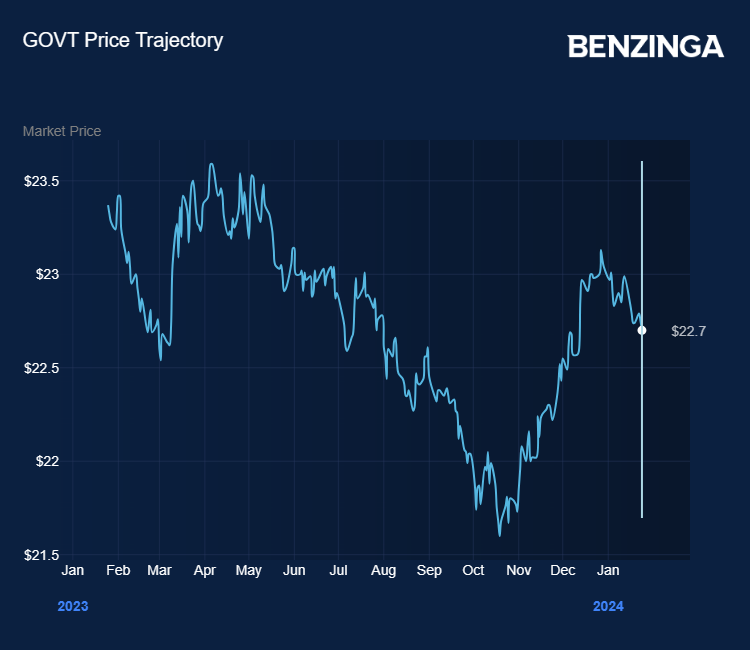Zinger Key Points
- Demand has returned for U.S. Treasuries despite increased supply
- Shift in demand is rooted in improved macro confidence and growing Fed rate cut expectations
- Feel unsure about the market’s next move? Copy trade alerts from Matt Maley—a Wall Street veteran who consistently finds profits in volatile markets. Claim your 7-day free trial now.
The U.S. Treasury is expected to confirm next Wednesday, Jan. 31, further increases in government bond supply in its first quarterly refunding announcement of 2024. But is demand sufficient for the government to auction the debt at top prices and comfortable yields?
Treasury demand dropped off sharply at the beginning of the final quarter in 2023 as top foreign buyers such as China and Japan focused their energies on their own debt in support of their capital markets and currencies.
At this point yields began to move higher, peaking in mid-October at above 5%. The benchmark 10-year yield peaked at 5.021% on Oct. 23.
Subsequently, as markets became aware that the Federal Reserve’s rate hike cycle had peaked, bond yields fell sharply. Demand for Treasuries began to return as hopes improved that an economic slowdown wouldn’t deteriorate into recession.
“Last fall, the U.S. Treasury market was dominated by one question: who will buy the bonds?,” said Mark Cabana, rates analyst at Bank of America. “At that time U.S. data was hot, Fed hikes were in play, term premium measures were rising, Treasury demand was tepid.”
Treasury Demand Returns
But what a difference a season makes. As fall turned into winter, demand for Treasuries improved.
“The shift in Treasury demand is fundamentally rooted in improved macro confidence and growing Fed rate cut expectations,” said Cabana. “And the January Treasury refunding announcement will not rock this boat.”
Treasury refunding is an important part of government financing. As Treasury bonds mature to their duration — whether that be two, five, 10 years etc. — the government must pay the bondholder the current market price value of the bond.
Billions of dollars worth of government debt expires like this every year and the government must issue more debt to pay it down.
January Refunding
Cabana’s team at BofA believes the Treasury will deliver a repeat of the increase in auction sizes announced in November.
This saw increases in the two- and five-year Treasuries of $3 billion per month; the three-year by $2 billion per month and the seven-year by $1 billion a month.
It also increased both the new issue and the reopening auction size of the 10-year note by $2 billion and the 30-year bond by $1 billion. It maintained the 20-year bond new issue and reopening auction size.
Investors can track bond price movements through exchange-traded funds (ETFs). Prices move inversely to yields, so as Treasury yields have ticked a little higher at the start of the year, prices have eased.
The iShares U.S. Treasury Bond ETF GOVT, an ETF that tracks U.S. government bonds through the entire range of maturities, is down 1.5% so far this year.

Meanwhile, the Schwab Short-Term U.S. Treasury ETF SCHO, tracks U.S. government bonds between one and three-year maturities, and the Schwab Intermediate-Term U.S. Treasury ETF SCHR, tracks U.S. government bonds with durations of around five years.
Thus, with higher supply, can demand keep pace? So far it has, said Cabana.
“Overall, elevated Treasury supply concerns have not resulted in a consistent deterioration of auction performance,” he said, adding: “Improved Treasury demand can be observed across a wide range of investors, ranging from banks to pensions to foreign investors. Japanese banks have increased foreign bond buying, likely as more tactical trades.”
Treasury supply will remain a powerful consideration in the Treasury market for some time to come, as investors must also take into account twin deficits.
US deficits are still large and growing, which means that UST supply will remain heavy.
“We expect reduced macro uncertainty and Fed cuts will be supportive of Treasury demand in the near term. However, Treasury supply concerns are likely to resurface over time,” concluded Cabana.
Now Read: Treasury Market Stress: Primary Dealers Taking Up Slack As Foreign Demand Fades
Image: Shutterstock
Edge Rankings
Price Trend
© 2025 Benzinga.com. Benzinga does not provide investment advice. All rights reserved.
Trade confidently with insights and alerts from analyst ratings, free reports and breaking news that affects the stocks you care about.